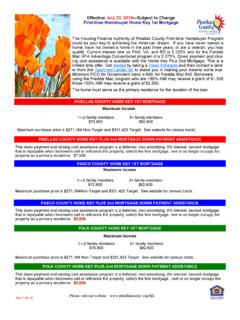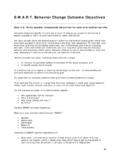Transcription of Time for a Change: Recommended MTOE Rank …
1 time for a change : Recommended MTOE rank adjustment for Army Special Operations Physician Assistants Major John F. Detro The Army is rapidly expanding its Special Operations Forces (SOF) capability to meet the demands of the Global War on Terrorism (GWOT). Due to this expansion, there is a need for more and better-experienced SOF physician assistants (PA). In 2008, the Physician Assistant Section, Army Medical Specialist Corps (AMSC) updated its Career Life Cycle Model. Career branch managers and individual PAs employ this model to chart career progression. According to this model, Army PAs can serve in SOF units (Appendix A) until reaching the rank of Lieutenant Colonel (P). The Modified Table of Allowances and Equipment (MTOE) is the Army s organizational structure for assigning individuals and equipment ( ) to a specific tactical unit.
2 Currently, the MTOE within the SOF community only supports hiring of PAs with the rank of Captain or Major and retention up to the rank of Major (exception USSOCOM). With the need to retain and expand the number of high quality PAs within the community, an MTOE change is required within all Army SOF units. This change will balance the PA life cycle model with actual MTOE allocations within SOF units. The overall effect would be the retention of increased numbers of experienced PAs within the SOF community. During the 1970s, the Army was losing many physicians to civilian practice. Due to this shortage, military physicians saw a need for developing a military PA profession. Congress authorized the training of Army PAs and training began in 1971.
3 The first class graduated in 1973. The other Services quickly followed the Army s lead and established their own programs. Later, these programs combined to form one school. Today, the Interservice Physician Assistant Program (IPAP) is the only Department of Defense institution for training military PAs. The IPAP is the largest PA program in the United States with approximately 200 graduates annually. Approximately 115 of the current students are active duty Army. Today, PAs work in all types of medical and surgical practice environments. Advanced training in formal residencies such as orthopedics, general surgery, and emergency medicine are available. Despite these specialties, the majority of Army PAs serve in combat arms units.
4 Currently, of the 973 Army PAs serving on active duty, 97% have deployed to combat with an average combined deployment time being 29 months. Special Operations units conduct unconventional missions in austere environments. Due to the remoteness of these missions and the lack of direct physician oversight, the employment of more seasoned PAs is imperative. Currently, according to Lieutenant Colonel Earl Buck Benson, USASOC Senior PA (personal correspondence), USASOC employs mainly company grade physician assistants. Currently, the United States Army Special Operations Command (USASOC) and Joint Special Operations Command (JSOC) are expanding the number of assigned personnel.
5 An increase in Special Operations rank structure is necessary given the complexity of Special Operations missions and the investment in training of PAs. By utilizing more experienced PAs, the Special Operations medical community can decrease the risk of medical errors, medic-training shortcomings, enhance mission planning, and improve patient care. Assignment in a Special Operations unit requires that PAs serve one tour in the Regular Army (RA). These tours can range from one to three or more years. Currently, students graduate from the IPAP as First Lieutenants or higher (based on prior service) with two years time in grade.
6 Given no adverse performance, in two years they will become Captains. Generally, after eight years serving as a PA, individuals are promoted to Major. Given the need to serve a RA assignment, most PAs enter the SOF community as a mid-level Captain with two to four years time in grade. Therefore, upon assignment to Special Operations units, within two to six years these PAs will be Majors. The majority of Special Operations allocations for PAs are for Captains; exceptions include a few Major positions within USASOC headquarters and JSOC units along with one Lieutenant Colonel slot at USSOCOM. Upon promotion to Major, Special Operations PAs must make career decisions. Individuals could attempt to obtain one of the few Special Operations Major allocations.
7 If unable to obtain a position for a Major, an individual could remain in the lower ranked position. This may be attractive for individuals who are looking toward retirement or plan to leave the service after completing any service obligations. However, for those hoping to remain competitive for promotion to Lieutenant Colonel, many choose a Permanent change of Station (PCS), and an assignment to a conventional position, which prepares them for the next higher rank . Either way, these highly qualified PAs leave the community. According to the career life cycle model, PAs should move between three career paths: education, leadership, and patient care. The goal of this model is to promote diversification as PAs serve in all three tracks.
8 However, it is possible to stay within one track for longer periods. This model depicts PAs serving in Special Operations units from approximately their fifth to sixteenth years of PA service. By this standard, individuals could stay within Special Operations units from the rank of Captain until selected for promotion to Colonel. However, the current MTOE allocations reflect a different reality. Below is a list of the current allocations by unit. Currently, many Majors occupy Captain positions. These numbers derive from available MTOE tables (36 PAs with 8 pending) and personal knowledge. Unit Number of PAs rank Total Special Operations Groups Four groups with four battalions each 25 (4 per battalion, 1 Group HQ) 03 25 Special Operations Aviation Regiment (160thFour battalions ) 5 (1 per Battalion, 1 Regimental HQ) 03 5 75thThree battalions Ranger Regiment (4 battalions) 8 (2 per battalion, 2 Regimental HQ) 03/04 7/1 Joint Special Operations Command 8 03/04 8 Special Operations Command South (SOCSOUTH) 1 03 1 Southern Command (SOUTHCOM) 1 03 1 Special Operations Command (USSOCOM) 1 05 1 John F.
9 Kennedy Special Warfare Center & School 1 03 1 Special Warfare Center & School 1 03 1 Based on the need for highly experienced PAs within SO units, the community must change the PA MTOE to support the current life cycle model, PA career progression, and most importantly improve Soldier medical care and operational planning of Special Operations units. By upgrading the rank structure of PAs within all Special Operations units, the community will retain more highly qualified PAs for longer periods. The following is a proposed list of changes: Special Operations Groups: Upgrade all battalion slots to 04 and Group HQ slots to 05. Special Operations Aviation Regiment (SOAR): Upgrade battalion slots to 04 and the Regimental position to 05.
10 Ranger Regiment: Upgrade battalion slots to 04 and Regimental Senior PA to 05. Joint Special Operations Command: Upgrade all slots to 04 with two slots upgraded to 05. Upgrade USASOC/USSOCOM positions to 06, remaining positions upgraded to 04. The net outcome would represent a change from 49/3/1 Captains/Majors/Lieutenant Colonels to 42 /9/2 Majors/Lieutenant Colonels/Colonels. There are several advantages to these MTOE changes. These advantages benefit both the Special Operations community and Army Medical Specialist Corps (AMSC). First, upgrading the Special Operations PA rank structure balances the life cycle model with the MTOE. By increasing this PA rank str ucture, the Special Operations Command will gain forty-two Majors, nine Lieutenant Colonels, and two Colonels.





